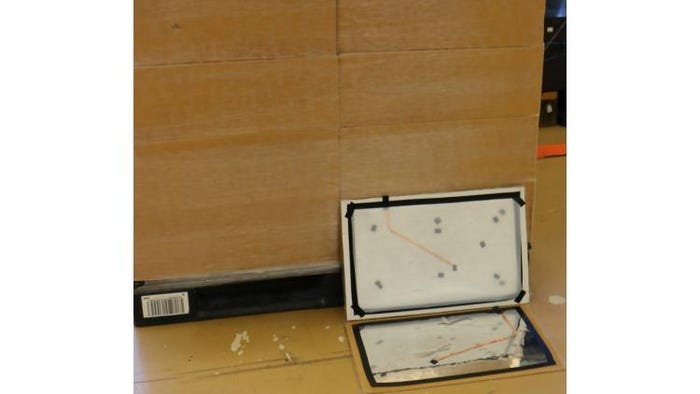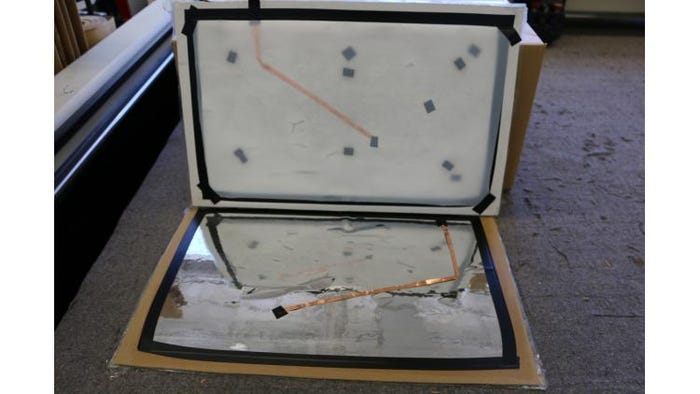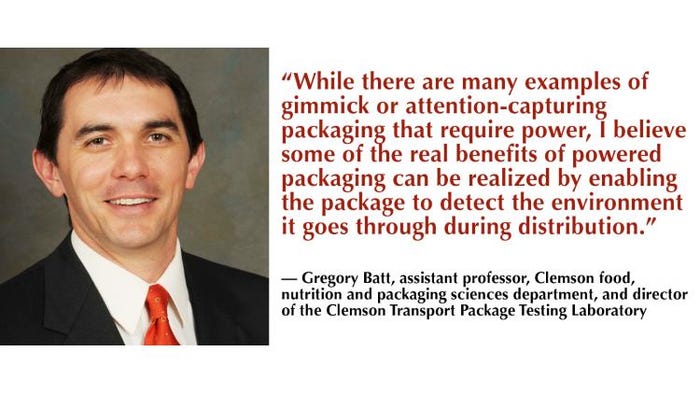Self-powered smart packaging now in development
Can friction between different material surfaces create enough energy to power smart packaging? Clemson researchers think so. And they now have $500,000 to prove the concept.
Gregory Batt, an assistant professor in the food, nutrition and packaging sciences department and director of the Clemson Transport Package Testing Laboratory, and James Gibert, a Clemson alumnus and assistant professor in the School of Mechanical Engineering at Purdue University, will be studying how to apply triboelectric technology to energize smart packaging, especially for transportation and supply chain applications.
What is triboelectric technology? If you’ve ever gotten a shock after walking across carpet and touching something metal, you’ve experienced it for yourself. Triboelectric technology is “a cost-effective means to replace or augment batteries and power devices by converting mechanical motion into electricity,” explains Gibert.
As explained in the video above, Clemson and Purdue researchers will collaborate to develop, test and optimize triboelectric energy harvesters, which can feed devices used to power smart packages. “This has far-reaching implications in powering devices in the hyper-connected world known as the ‘internet of things’” Gibert says.
Batt and Gibert answer Packaging Digest’s questions about the technology and its applications for smart packaging.
In the video, you’ve explained how the power is generated. But how is that energy then collected and transferred in a smart packaging application?
Batt: Power is collected through the charging of a battery or super-capacitor. This is how continuous power can be delivered in a smart packaging application even when the load is not in motion.
Can this self-powered package/device be reused? If so, how many times?
Batt: We have done some preliminary “durability” testing with the energy harvester we prototyped and were successful with multiple vibration tests simulating several cross-country trips. However, much more validation of this must be done. This testing is part of the grant.
Do you have a formula yet for figuring out how much power can be generated/absorbed with a particular size package/device?
Gibert: There is no simple formula, this depends on the surface charge density of the polymer, the area of contact and even the rate at which the two surfaces come in contact. We and others have done some preliminary modeling of this behavior. We are working towards a unified model.
In the video, you talk about one possible transportation packaging application. Do you have any primary packaging examples?
Batt: It is certainly possible to scale the device to work inside a primary package. It would have to be the smart packaging device that would drive the primary package need for power.

A triboelectric device placed between pallet layers can also mitigate damage to the load due to vibration.
In your pallet shipping example, devices between layers would absorb some of the vibration the packages inside the cases would normally experience. This absorption would help mitigate primary packaging damage. Might one benefit of this be that packaging engineers could reduce the amount of packaging materials required for product protection?
Batt: Absolutely. While our focus is energy harvesting from the device, we have already demonstrated that such a device could reduce transmitted forces and/or shift the resonant frequency of a stack of packaged products to a more desired frequency. Either of these results have the potential of reducing package material requirements. Quantifying the ability to mitigate input forces is part of the research plan.
Your example mentions metallized film rubbing against a polymer film. What other packaging-material combinations can self-generate power either with repeated contact or through friction?
Batt: There are a variety of materials that exhibit this behavior. [See page 2 of this article for a list of materials based on their polarity.] This behavior is observed in two materials that are at opposite ends of the list. The further apart they are in polarity, the more effective they are in generating the voltage difference.

One example of a triboelectric device uses polymer film on one side and metallized film on the other to generate the charge.
Do you think consumers would appreciate a self-powered package? Why or why not?
Batt: While there are many examples of gimmick or attention-capturing packaging that require power, I believe some of the real benefits of powered packaging can be realized by enabling the package to detect the environment it goes through during distribution. Capturing the exposure history to quantities—such as temperature, moisture, acceleration and atmospheric pressure—can benefit package designers and consumers alike in assuring product safety.

Could the technology involve the consumer somehow to help the package generate the power—similar to how some emergency radios run after a person cranks a handle?
Batt: This is possible. The consumer could shake the packaged product and provide the necessary input.
Is there any risk of creating sparks or causing a fire?
Batt: While voltage can be high, current is very low, making the risk of fire no greater than you walking across your carpet in the winter time.
How does incorporating this technology affect a package’s recyclability or sustainability?
Batt: This is a great question that will depend on the materials selected.
How much might this technology cost and how does that compare to other existing smart packaging technologies?
Batt: It is too early to make cost estimates as the current research is focused on the optimization of the device. Our current prototypes are made from common materials used in packaging.
What direction will your research go now that you have received a $500,000 grant from the National Science Foundation?
Gibert: The grant’s goals, as funded, are to:
1. Understand the molecular scale mechanism of charge transfer due to the contact electrification process based on the hypothesis that the phenomena is due to an ion exchange between two surfaces.
2. Understand the interplay of the macro- and micro-scale properties of the device that affect its performance—such as the effect of the elastic elements in the device on its response, the composition and surface texture of the dielectric and the effect of the real contact area of the device.
3. Elucidate the effect of environmental conditions such as humidity and temperature on the performance of these devices.
The understanding from these objectives will culminate in a testbed concept of a triboelectric foam composite to be used in smart packaging for concurrent energy scavenging and vibration suppression.
These devices can be used in many applications but their low cost and materials make smart packaging an ideal application.
************************************************************************
Learn what it takes to innovate in the packaging space at MinnPack 2017 (Nov. 8-9; Minneapolis). Register today!
Tribo Series
Materials
(+) More Positive
Glass
Mica
Polyaamind (Nylon 6,6)
Rock Salt (NaCl)
Wool
Fur
Silica
Silk
Aluminum
Polyvinyl alcohol (PVA)
Polyvinyl acetate (PVAc)
Paper
Cotton
Steel
Wood
Amber
Polymethl methacrylate (PMMA)
Copper
Silver
Gold
Polyethylene terephthalate (Mylar)
Epoxy Resin
Natural Rubber
Polyacrylonitrile (PAN)
Polyvinylidene chloride (Saran)
Polystyrene (PS)
Polyethylene (PE)
Polypropylene (PP)
Polyvinyl chloride (PVC)
Polytetrafluorethylene (Teflon, PTFE)
(-) More Negative
************************************************************************
Learn what it takes to innovate in the packaging space at MinnPack 2017 (Nov. 8-9; Minneapolis). Register today!
About the Author(s)
You May Also Like




